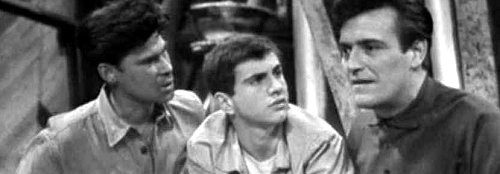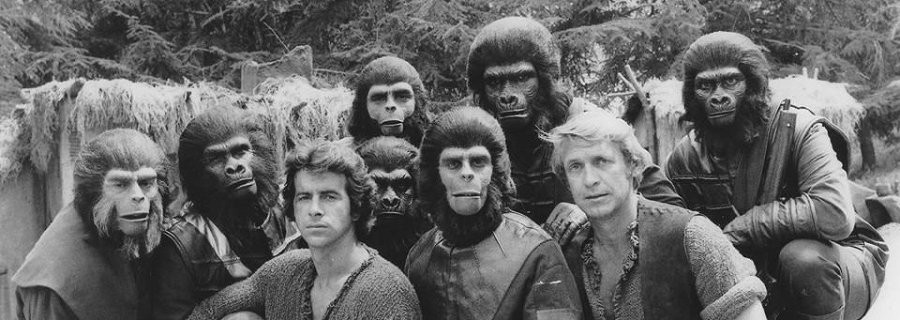
The Starlost
Creator Harlan Ellison earned a Writer’s Guild of America award for his original pilot script in 1974. The end product that reached our TV screens was dismal beyond compare.
It's the year 2285, and a giant spaceship, the Ark, drifts through deep space, out of control, its crew having been killed several hundred years earlier by some horrible catastrophe. When this happened the airlocks connecting the ship's numerous domed environments closed, cutting the inhabitants off from the outside world. Over time, and as a result of isolation, many of the dome's communities forgot that they were on a spacecraft. They merely accepted that their world was small and that the sky was metal. They also forgot that after the accident they all would eventually be in extreme danger. Without a crew to helm the ship, and the dome inhabitants living solitary lives, the Ark was on a collision course with a sun. However, one man eventually stumbles upon the truth.
This man is Devon (Kier Dullea). Orphaned when his parent's farm burned, he is something of a dreamer. He has had to educate himself although is also fairly naïve but learns quickly when he discovers the truth. He is prone to ask many questions, most of the wrong sort. As a result of this he is banished from his community of Cyprus Corners. And once he is forced to leave the safety of his dome, Devon goes on a personal quest to find "what's out there". It is here that he discovers that he lives inside a giant dome on a spaceship.
Rachel (Gay Rowan) joins Devon in his quest. She is in love with Devon despite having been promised to Garth. As a result, Rachel chooses to follow Devon as he travels into the depths of the Ark. Rachel is a very 'traditional' sort of woman - raised to be nothing more than the servant of the man she was promised to at birth. However, she discovers the joys of being in control of her own destiny and of making her own decisions once she leaves the confines of Cyprus Corners. Devon and Rachel are eventually joined by Garth (Robin Ward), a trained blacksmith. Although Rachel was promised to him at birth, he does not love her and wishes that the Elders would give her permission to marry Devon. But when Devon and Rachel leave the dome, Garth is forced by honour to follow and track down the two.
The ship is an organic unit, made up of a series of clustered separate globular environmental domes, each some fifty miles in diameter. Tubular corridors that carry life support, power, communications and other systems link the domes. The overall length of the ship is about 200 miles. Each dome contains a completely enclosed ecology large enough to support a sizable population of colonists. From the inside the dome could look and "feel" like an isolated valley -- large enough to sustain villages and farms, streams and hills, forests and meadows. But this "valley" is walled not by mountains but by the structure of the dome itself.
Power for the entire ship comes from a set of hydrogen fusion reactors called CTR's (Controlled Thermonuclear Reactors). While the ship's propulsion is achieved by a field drive, technically this is not a rocket but in essence the field drive takes the energy output from the CTR's and coverts it directly into acceleration and motion. The field drives use electromagnetic and gravemetric forces rather than the simple pressure and reaction forces of a rocket. In one of the smaller domes aboard the ship there is the bridge, a central computer facility, and crew's quarters - that is the crew that runs the ship. Presumably, this section was heavily damaged or destroyed outright in whatever calamity damaged the ship.
Within each environmental dome, the transportation systems employed are consistent with the culture of that group of colonists. But in the tube tunnels, the ship's transportation system can consist of gravimetric transports, or "bounce tubes," where a person merely steps into the proper area and is whisked along, or up, or down -- more or less like a person falling from a height. But the end of the journey is a pleasant and feather-soft stop -- somewhat better than landing on the ground from a parachute jump. The ship is built of domes and tubes so that individual domes, or whole clusters of them, can be separated and placed in orbit about a planet, if and when the colonists decide to do so. The domes themselves are not meant to land on any planetary surface.
The Starlost debuted in 1973 and was CTV's attempt at producing a quality science fiction television series made in Canada. Based on a novel by Harlan Ellison the series promised to be a monumental step for sci-fi television. Series creators, Harlan Ellison and Ben Bova had contacted numerous well-known science fiction writers of the day to contribute storylines and scripts to the fledgling series. The series would be executive produced by Douglas Trumball, and state-of-the-art special effects would be provided via the revolutionary intergration process called Magicam. The creative team behind the series had high hopes for the show. It all sounded great on paper and in theory, but it all fell apart by the time The Starlost reached television screens.
Sadly what had started out as a great idea, quickly turned into a typical low budget, syndicated series. The SFX proved extremely problematic. The original intention to shoot the series entirely on videotape utilizing Magicam had to be abandoned when this turned out to be of very poor quality, grainy and spotty, and the production team were eventually forced to use Chromakey. Plus the series was hampered by a very low budget, $100,000 per-episode, which was less than was being spent on Star Trekalmost a decade before. Both Douglas Trumbull and Harlan Ellison left the series over creative problems before it went into production. The series creator credit eventually went out under Ellison's pen name, while his pilot episode was retained to launch the series. Of all the writers that Ellison and Bova invited to write for the series, only Ursula K. LeGuin's storyline made it into production. Although Ellison earned a Writer’s Guild of America award for his original pilot script in 1974 he was quick to distance himself from the production.
The end product that reached our TV screens was dismal beyond compare and the show was quickly axed after with only 16 episodes aired. To date the series is regarded as the worse example of science fiction television ever produced and as resulting fiasco the series caused a severe blow to Canadian produced series, setting them back years.
Published on February 22nd, 2019. Written by Bob Furnell for Television Heaven.









